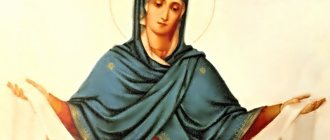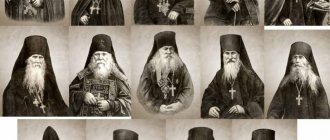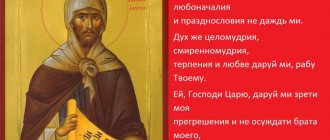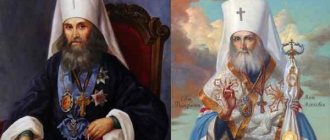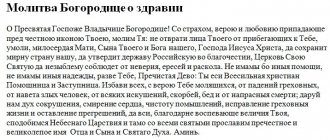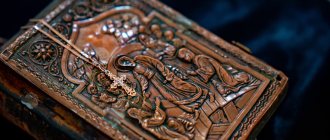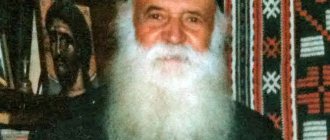Russian Orthodox Church
print version
The order of readings, according to the calendar:
Polyeleos service in honor of Sschmch. Hermogenes may be moved to Tuesday, February 16 (cf. Typikon, February 24, 4th Markov chapter).Beginning with Vespers, services are performed similarly to Lenten ones: according to “Now you let go” - fasting troparia with bows. At the end of Vespers, Great Compline, Midnight Office, Matins, every hour, pictorial - the prayer of St. Ephraim the Syrian with bows.
At Matins “Alleluia” and the Trinity according to the voice of Octoechos. Canons of Octoechos, Menaion, Triodion with Trisongs. The Lenten troparia on the hours and the Blessed on the icons are read.
17. Cheese Wednesday. Vmch. Theodore Tyrone.
Sschmch. Hermogenes, Patriarch of Moscow and All Russia, wonderworker. St. Barnabas of Gethsemane, Radonezh.
Military service. Theodora Tiron is celebrated together with the services of Octoechos and Triodion.
Note.
Polyeleos service in honor of Sschmch. Hermogenes, Patriarch of Moscow and All Russia, wonderworker, may be moved to Tuesday, February 16 (cf.: Typikon, February 24, 4th Markov chapter).
At Vespers
Kathisma 9th.
On “Lord, I cried” stichera at 6: Octoechos, tone 3 – 3, and martyr. Theodora, voice 2 – 3[1]. “Glory” - martyr. Theodora, voice 6: “The gift of the Holy Orders...”, “And now” - Menaion of the Holy Cross, the same voice: “Weapons, as Simeon spoke...”.
No entry. Prokeimenon of the day.
The poem contains the stichera of the Triodion, tone 1 (with the usual choruses). “Glory” - martyr. Theodora, voice 8: “With suffering courage...”, “And now” - Menaion of the Holy Cross, the same voice: “The Undefiled Youth...”.
According to the Trisagion - troparia, tone 4: “To the Virgin Mary...” (bow)[2]. “Glory” – “To the Baptist of Christ...” (bow), “And now” – “Pray for us...” (bow), “Under Your mercy...” (without bow). Reader: “Lord, have mercy” (40), “Glory, even now,” “The most honorable Cherub...”, “Bless the name of the Lord, father.” Priest: “Blessed be he...” Reader: "Amen." Prayer: “Heavenly King...” Priest - prayer to St. Ephraim the Syrian: “Lord and Master...” (divided into three parts and with a great bow after each), then 12 small bows with the prayer: “God, cleanse me, a sinner,” and again one great bow at the end of the prayer: “Lord and Master..." (without division into parts). Reader: Trisagion[3]. According to the “Our Father” the priest - an exclamation. Reader: “Amen”, “Lord, have mercy” (12). Priest: “Glory to Thee, O Christ God...” Singers: “Glory, even now,” “Lord, have mercy” (three times), “Bless.” The priest creates a great release.
Great Compline is celebrated with bows (at Compline, singing is replaced by reading everywhere).
According to “It is worthy...” and the Trisagion, it is not sung, as during Great Lent, “Lord Almighty, be with us...”, but the troparia of Lesser Compline, namely:
In the Church of the Lord there is a daily troparion: “Save, O Lord, Thy people...”. “God our father...”, “Those all over the world...”. “Glory” - “Rest with the saints...”, “And now” - “Through prayers, Lord...”.
In the Church of the Mother of God and the Saint there is a daily troparion: “Save, Lord...”, the troparion of the temple. “God our father...”, “Those all over the world...”. “Glory” - “Rest with the saints...”, “And now” - “Through prayers, Lord...”.
Reader
: “Lord, have mercy” (40). Prayer: “Likewise at all times...” “Lord, have mercy” (three times), “Glory, even now,” “The most honorable Cherub...”, “Bless in the name of the Lord, father.” Priest - exclamation: “God, be generous with us...”. Reader: "Amen." Priest - prayer to St. Ephraim the Syrian (with 16 bows). Reader: "Amen." The final Trisagion. According to the “Our Father” the priest - an exclamation. Reader: “Amen”, “Lord, have mercy” (12). Prayers: “Undefiled, Unblasphemous...”, “And grant us, Master...”, “Glorious Ever-Virgin...”, “My Hope...”. Priest: “Glory to Thee, O Christ God...” Choir or reader: “Glory, even now,” “Lord, have mercy” (three times), “Bless.” Priest – small release (but not “Master of Much Mercifulness...”). The usual forgiveness from the rector and the litany: “Let us pray for the Great Lord...”, at the end of which the priest says: “Rtsem and for yourself samekh.” Choir: “Lord, have mercy” (three times). Priest: “Through the prayers of our holy fathers...” Chorus: "Amen."
Daily Midnight Office with “her bows” and prayer to St. Ephraim the Syrian (with 16 bows).
At matins
at the cry “Blessed is our God...” - Trisagion. According to the “Our Father” the priest exclaimed: “For Thine is the Kingdom...”. Reader: “Amen”, “Lord, have mercy” (12), “Glory, even now”, “Come, let us worship...”, psalms 19 and 20, and so on in order[4].
Instead of “God is the Lord” - “Alleluia” in the voice of Octoechos (in this case the 3rd). Trinity voices (as during Great Lent). Kathismas 10th and 11th. There are no small litanies.
According to the 1st verse - sedalny Octoechos, voice 3rd.
According to the 2nd verse - sedalny Triodion, voice 2nd.
Psalm 50.
Bible songs “We sing to the Lord...”.
Canto 1 – Octoechos 1st canon[5] with irmos, without martyrs, on 4 (irmos once), Menaion (Martyr Theodore) on 6 (without irmos, canto 1st and 3rd), Triodion complete canon on 4 (without irmos, canto 1).
Canto 3 – Triodion full canon with irmos for 6 (irmos once), three songs of the Triodion for 8 (without irmos)[6].
For the catavasia - Irmos of the 2nd triple song, voice 2: “My unfruitful mind...”.
According to the 3rd song - small litany; sedal vmch. Theodora, voice 4th. “Glory, even now” - Menaion of the Holy Cross, the same voice: “Who is from the Father Without Beginning...”.
Canto 4 – Octoechos 1st canon with irmos for 6 (irmos once), Menaion (martyr Theodore) for 4 (without irmos, 4th canto), Triodion full canon for 4 (without irmos, 4th canto) ).
Canto 5 – Octoechos 1st canon with irmos for 6 (irmos once), Menaion (martyr Theodore) for 4 (without irmos, 5th canto), Triodion full canon for 4 (without irmos, 5th canto) ).
Canto 6 – Octoechos 1st canon with irmos, without martyrs, on 4 (irmos once), Menaion (martyr Theodora) on 6 (without irmos, canto 6th and 8th), Triodion full canon on 4 (without irmos, canto 6).
In response to the chaos - the irmos of the complete canon of the Triodion, tone 4: “Like the prophet Jonah...”.
According to the 6th song - small litany; kontakion and ikos vmch. Theodora, voice 8th.
Canto 7 – Octoechos 1st canon with irmos, without martyrs, on 4 (irmos once), Menaion (martyr Theodora) on 6 (without irmos, canto 7th and 9th), Triodion full canon on 4 (without irmos, canto 7).
Canto 8 – Triodion full canon with irmos for 6 (irmos once), three songs of the Triodion for 8 (without irmos). “We praise, we bless...”
In response to the chaos - the irmos of the 2nd three-canticle, the 2nd voice: “In the bush of Moses the Virgin received a miracle...”.
On the 9th song we sing “The Most Honest”. (The usual incense is performed.)
Canto 9 – Triodion full canon with irmos for 6 (irmos once), three songs of the Triodion for 8 (without irmos).
In response to the chaos - the Irmos of the 2nd three-canticle, the 2nd tone: “Prenaturally formed in the flesh...”.
According to the 9th song, “It is worthy to eat” is sung. Small Litany. The luminary voices of the Trinity (as during Great Lent).
“Praise the Lord from Heaven...” and psalms of praise.
The daily doxology is read.
The poem contains the stichera of the Triodion, tone 1 (with regular refrains). “Glory” - martyr. Theodora, voice 2: “Divine gifts...”, “And now” - Menaion of the Holy Cross, the same voice: “All-ripe grape, Pure...”.
“There is goodness...” (once)[7]. Trisagion. According to the “Our Father” the priest exclaimed: “For Thine is the Kingdom...”. After the exclamation, the troparion is said: “In the temple, worthy of Thy glory...”. “Lord, have mercy” (40), “Glory, even now,” “The most honorable Cherub...”, “Bless the name of the Lord, father.” Priest: “Blessed is Christ...” Reader: "Amen." Prayer: “Heavenly King...” Priest - prayer to St. Ephraim the Syrian (with 16 bows). Reader: “Amen,” and immediately (without the dismissal of Matins) – 1st hour.
Note.
There are no kathismas on the clock. There are no bells struck at every hour, as is customary during Lent.
1st hour “Come, let us worship...” (three times) and ordinary psalms. According to the Lenten rite, the troparion is read (but not sung): “Tomorrow hear...” with its own verses (verse 1: “Inspire my words, Lord...”, and verse 2. “For I will pray to Thee...”). “Glory, even now” – Theotokos of the hour: “What shall we call Thee...”. The verses of the hour: “Direct my feet...” and “Let my mouth be filled...” are read[8]. Trisagion. According to the “Our Father” the priest - an exclamation. Reader - troparion: “Soon foreshadow...”. “Lord, have mercy” (40). Prayer: “Likewise at all times...” “Lord, have mercy” (three times), “Glory, even now,” “The most honorable Cherub...”, “Bless in the name of the Lord, father.” Priest: “God, be gracious to us...” Reader: "Amen." Priest - prayer to St. Ephraim the Syrian (with 16 bows). Reader: "Amen." The final Trisagion. According to the “Our Father” the priest - an exclamation. Reader: “Amen”, “Lord, have mercy” (12). Priest: “Christ, the True Light...”. Choir (according to custom): “To the elected Voivode...”. Priest: “Glory to Thee, O Christ God...” Chorus: “Glory, even now,” “Lord, have mercy” (three times), “Bless.” Release and perennial. Departure into the narthex and the usual litany for the departed.
3rd hour The priest in the stole, in front of the royal doors (the curtain does not open), having made three bows (from the waist), pronounces the exclamation: “Blessed is our God...”. Reader: “Amen”, “Glory to Thee, our God...” and other sequences of the 3rd hour, as usual. According to the Lenten rite, the troparion is read (but not sung): “Lord, Who is Your Most Holy Spirit...” with its verses (verse 1: “Create a pure heart in me, O God...”, and verse 2: “Do not reject me from Your presence..."). “Glory, even now” – Theotokos of the hour: “O Mother of God, You are the true vine...”. “Blessed be the Lord God...”, Trisagion. According to the “Our Father” the priest - an exclamation. Reader – troparion: “Blessed art thou, O Christ our God...”, “Glory” – introparion: “Give quick and well-known consolation...”, “And now” – Theotokos: “Hope and intercession...”. “Lord, have mercy” (40). Prayer: “Likewise at all times...” “Lord, have mercy” (three times), “Glory, even now,” “The most honorable Cherub...”, “Bless in the name of the Lord, father.” Priest: “God, be gracious to us...” Reader: "Amen." Priest - prayer to St. Ephraim the Syrian (with 16 bows). Reader: "Amen." Prayer: “Sovereign God...”, and the 6th hour begins.
6th hour. “Come, let us worship...” (three times) and ordinary psalms. According to the Lenten rite, the troparion is read (but not sung): “And on the sixth day and hour...” with its verses (verse 1: “Inspire, O God, my prayer...”, and verse 2: “Az to I cried to God..."). “Glory, even now” - Theotokos of the hour: “For the imams are not bold...”. Reader - troparion of prophecy (Triodion), voice 3: “To the Holy King...”, “Glory, and now” - the same troparion. Priest (or deacon): “Let us attend.” Reader – Prokeimenon of Triodion, tone 6: “Save, O Lord, Thy people...”; verse: “To You, O Lord, I will cry...”[9]. Priest (or deacon): “Wisdom.” Reader: “Reading the Prophecies of Joel.” Priest (or deacon): “Let us attend.” The reader reads the parody of the Triodion. At the end of the reading, the priest (or deacon): “Let us hear.” Reader – prokeimenon of Triodion, tone 7: “The Lord will give strength to His people...”; verse: “Bring it to the Lord, sons of God...” After singing the prokeemna, the reader: “Soon let us be preceded by...”, Trisagion. According to the “Our Father” the priest - an exclamation. Reader – troparion: “Thou hast wrought salvation...”, “Glory” – introparion: “To Thy Most Pure Image...”, “And now” – Holy Cross: “Glorified art thou, O Virgin Theotokos...”. “Lord, have mercy” (40). Prayer: “Likewise at all times...” “Lord, have mercy” (three times), “Glory, even now,” “The most honorable Cherub...”, “In the name of the Lord...”. Priest: “God, be gracious to us...” Reader: "Amen." Priest - prayer to St. Ephraim the Syrian (with 16 bows). Reader: "Amen." Prayer: “God and the Lord of hosts...”, and the 9th hour begins.
9th hour “Come, let us worship...” (three times) and ordinary psalms. According to the Lenten rite, the troparion is read (but not sung): “Even at the ninth hour...” with its own verses (verse 1: “Let my prayer come near...”, and verse 2. “Let my petition be accepted...”) . “Glory, even now” - Theotokos of the hour: “For our sake...”. “Do not betray us to the end...”, Trisagion. According to the “Our Father” the priest - an exclamation. Reader – troparion: “Seeing the thief...”, “Glory” – introparion: “In the midst of the two thief...”, “And now” – Holy Cross: “The Lamb and the Shepherd...”. “Lord, have mercy” (40). Prayer: “Likewise at all times...” “Lord, have mercy” (three times), “Glory, even now,” “The most honorable Cherub...”, “Bless in the name of the Lord, father.” Priest: “God, be gracious to us...” Reader: "Amen." Priest - prayer to St. Ephraim the Syrian (with three great bows). Reader: "Amen." Prayer: “Sovereign, Lord Jesus Christ, our God...”, and they begin with pictures. (According to tradition, the curtain of the royal gates opens.)
The pictorial readings read: “Bless, my soul, the Lord...”, “Glory” - “Praise, my soul, the Lord...”, “And now” - “The Only Begotten Son...”. Blessed without singing: “In Thy Kingdom...”. “Glory, even now” - “Remember us, Lord...”, “Remember us, Master...”, “Remember us, Holy One...”, “Heavenly Face...”, “Come to Him...”, “Heavenly Face...”. “Glory” - “The Face of the Saints Angels...”, “And Now” - “I Believe...”, “Weaken, Forsake...”, “Our Father.” Priest - exclamation. Reader: “Amen,” and reads the kontakion.
Kontakia:
In the Church of the Lord there is a daily kontakion and a martyr’s kontakion. Theodora. “Glory” - “Rest with the saints...”, “And now” - “Representation of Christians...”.
In the Church of the Mother of God there is a daily kontakion and a great kontakion. Theodora. “Glory” - “Rest with the saints...”, “And now” - the kontakion of the temple.
In the temple of the saint there is a daily kontakion, a temple kontakion, and a martyr’s kontakion. Theodora. “Glory” - “Rest with the saints...”, “And now” - “Representation of Christians...”.
Reader
: “Lord, have mercy” (40). “Glory, even now”, “More honorable than the Cherubs...”, “In the name of the Lord...”. Priest: “God, be gracious to us...” Reader: "Amen." Priest - prayer to St. Ephraim the Syrian (with 16 bows).
And Vespers begins immediately. Reader: “Amen”[10]. “Come, let us worship...” (three times), Psalm 103. Great Litany. The 12th kathisma will be sung, followed by the small litany.
On “Lord, I cried” stichera on 6: Octoechos, tone 3 – 3, and St. Leo, Pope of Rome, tone 8 – 3 (see February 18). “Glory, even now” - the Mother of God of the Menaion, the same voice: “To whom have you become like...”.
No entry. "Quiet Light" The deacon (or priest) exclaims (at the altar): “Let us attend.” Priest: “Peace to all”[10]. Reader: “And your spirit.” Deacon (or priest): “Wisdom. Let's remember." Reader – prokeimenon of the Triodion (day), tone 5: “God, in Thy name save me...”; verse: “God, hear my prayer...” Deacon (or priest): “Wisdom.” Reader: “Reading the Prophecies of Joel.” Deacon (or priest): “Let’s take a look.” The reader reads the parody of the Triodion. Deacon (or priest): “Let’s take a look.” Reader – Prokeimenon of Triodion, tone 6: “Let Israel trust in the Lord...”; verse: “Lord, my heart is not lifted up...” “Grant, Lord...” Litany of supplication: “Let us perform the evening prayer...”, and the prayer of adoration.
The poem contains the stichera of the Triodion, voice 3 (with regular refrains). “Glory, even now” - the Theotokos Triodion, the same voice: “First Holy, Pure...”.
According to the Trisagion - troparion of St. Leo, Pope of Rome, tone 8. “Glory, even now” - Theotokos according to the voice of the troparion, from the minor ones: “The mental gate...”. Litany: “Have mercy on us, O God...” Priest - exclamation: “For He is Merciful and Lover of Mankind...”. Chorus: "Amen."
Note.
After the exclamation of the litany: “For I am merciful...” - the usual exclamation: “Wisdom”, choir: “Bless”, priest: “Blessed are you...”. Prayer: “Heavenly King...” [or: “Confirm, O God...”] [12], after which - 3 great bows with the prayer of St. Ephraim the Syrian (cf.: Nikolsky K., Archpriest. A manual for the study of the Rules of Divine Services of the Orthodox Church. pp. 170–172, 230–234, 326).
Priest - prayer to St. Ephraim the Syrian (with three great bows). Reader: "Amen." Prayer: “All Holy Trinity...” “Be the name of the Lord...” (three times), “Glory, even now,” “I will bless the Lord...” (Psalm 33). Priest (or deacon): “Wisdom.” Chorus: “It is worthy to eat...” to the words: “and the Mother of our God” (inclusive). Priest: “Most Holy Theotokos, save us.” Choir: “Most honorable Cherub...” Priest: “Glory to Thee, O Christ God...” Chorus: “Glory, even now,” “Lord, have mercy” (three times), “Bless.” Release and, according to custom, are perennial. Departure into the narthex and the usual litany for the departed.
Note.
“It is known that there is, as in Palestine, as there is in the land of Jerusalem, it is not the order of the saints that the fathers create the perfect Liturgy on Wednesday and the heels of Cheese Week, below Presanctified: on those two days we sing Alleluia with bows, evening and morning, as above speech. During Vespers, in these two days, we eat cheese and eggs, one day resolving the rules of the Tetradites and Jacobites” (Typikon, chapter 49, “In this cheese Wednesday...”, 2nd “see”).
At Small Compline
the service of the Venerable is sung. Lev, ep. Katansky (from February 20).
Note.
“We say Small Compline, and we sing the canon of the Menaion on the Sabbath, wishing to receive the saint” (cf.: Typikon, chapter 49, “On this cheese Wednesday,” “On Wednesday evening”). For the order of singing services at Compline, see March 2, Tuesday of the 2nd week of Great Lent.
The order of troparions and kontakia is as follows:
In the Church of the Lord, the Mother of God, the Archangels or the Forerunner - the troparion of the temple, the troparion of the day: “Holy Apostles...”, “Rule of Faith...”. “God our father...”, “Those all over the world...”. “Glory” - “Rest with the saints...”, “And now” - “Through prayers, Lord...”.
In the Church of the Apostles[13] there are troparions of the day: “Holy Apostles...”, “Rule of Faith...”. “God our father...”, “Those all over the world...”. “Glory” - “Rest with the saints...”, “And now” - “Through prayers, Lord...”.
In the temple of the saint there are troparions of the day: “Holy Apostles...”, “Rule of Faith...”, troparion of the temple[14]. “God our father...”, “Those all over the world...”. “Glory” - “Rest with the saints...”, “And now” - “Through prayers, Lord...”.
Liturgy
not performed on this day.
Stichera of the Great Martyr.
Theodore Tiron (voice 4: “I am driven by Divine zeal...” etc.) are omitted. According to established church practice, the priest bows to the ground on the pulpit in front of the royal doors. In the Typikon this Trisagion is called “ultimate.” During the double psalm, the priest, as usual, performs the full incense of the temple with the royal doors closed. According to V. Rozanov (see his “Liturgical Charter of the Orthodox Church,” p. 435), both canons are sung from the Octoechos (1st - of the Cross, 2nd - of the Mother of God): in the 1st, 6th and 7th -th songs – with irmos for 4 (irmos of the 1st canon once; each canon for 2); in the 4th and 5th cantos - with irmos by 6 (irmos of the 1st canon once; each canon by 3). After the 2nd three-canticle of the Theotokos there is an additional troparion with the verse: “Glory to Thee, our God, glory to Thee,” which is not included in the count. How many times to say “Good is...”, the Charter in this case is silent, but you should know that in ordinary times (and even during fasting services during the singing of the Octoechos) the Typikon prescribes reading “Good is...” once, and on the fast days of Holy Pentecost when there is no special holiday, twice (see: Typikon, November 14, 4th “see”, cf. chapter 49; Rozanov V. Divine Service Charter of the Orthodox Church. P. 435). See: Nikolsky K., prot. A guide to the study of the Charter of Divine Services of the Orthodox Church. pp. 338–339. In the Typikon, about the prokeimenon at the Lenten service before parimia at the 6th hour and at Vespers, it is said: “The reader of the prokeimenon does not say, but will say: Tone 6: Save, O Lord, Thy people... The reader will only say the voice, but the prokeimenon will not say... "(see Typikon, "In this Cheese Wednesday"). About this instruction of the Charter, see: Nikolsky K., prot. A guide to the study of the Charter of Divine Services of the Orthodox Church. P. 212; Rozanov V. Liturgical Charter of the Orthodox Church. pp. 436–437, 512, 523; Bulgakov S.V. Handbook for clergy. K., 1913. M., 1993. P. 848; Liturgical instructions for 1956 for clergy. M., 1955. P. 49; Liturgical instructions for 1957 for clergy. M., 1956. P. 54; Liturgical instructions for 1958 for clergy. M., 1958. S. 40–41. For the final reading of the prayer, St. Ephraim the Syrian. At Vespers, the blessing “Peace to all” after “Quiet Light” is placed in cases where there is an entrance or parimia (cf.: Rozanov V. Divine Service Charter of the Orthodox Church. P. 437; 441, footnote). This blessing is also permissible at daily vespers without parimia (Ibid. p. 103). The tradition according to which, instead of the prayer “Heavenly King...” is sung: “Confirm, O God...” is acceptable. The troparion of the Temple of the Apostles is omitted, as it is replaced by the daily troparion. If the church of St. Nicholas, then his troparion is pronounced once, as a daily troparion. ← previous day next day →
Studite and Jerusalem Statutes
The most widespread in the Christian world were the Studite and Jerusalem liturgical Rules. Although over the history of the Church many more of them have been created.
Until the 14th century, the Studite Charter (9th century) was widespread. Its compiler is recognized as the Monk Theodore the Studite, abbot of the Studite Monastery in Constantinople.
In Rus', they began to adhere to the Studio Charter in 1070. It was introduced into the Kiev-Pechersk Lavra by the Monk Theodosius of Pechersk. Then the Charter was adopted by other monasteries. Since the 14th century, the Jerusalem Charter began to be used in the Russian Orthodox Church.
The Jerusalem Rule was originally compiled by the Monk Sava the Sanctified in the 6th century. But during the attack of the conquerors, the original was lost. Patriarch Sophronius of Jerusalem (6th century) restored the charter. But from the 8th to the 11th centuries, the Holy Fathers made additions to it.
In Orthodoxy, the liturgical rules developed for monastics were also used in parish churches for a long time. Over time, it became obvious that it was impossible to follow the monastic requirements in the conditions of everyday life “in the world.” Most of the world's people work and it is not possible to attend all services in church. Especially during long services during Lent. This also applies to observing strict fasting. According to the Rules, on the first day of Lent, complete abstinence from food is prescribed. Working Christians and children cannot do this (it can cause harm to health). Therefore, it is recommended to fast “in good conscience.”
Since the 17th century, these requirements began to be gradually reduced. The procedure for performing divine services in churches for the laity has acquired a modern look.
“In order for the liturgical unity of the Church to be observed, the liturgical regulations must be uniform. Therefore, “secular rules” and “monastic rules” cannot exist separately. The “monastic charter” was chosen as a role model. It most fully reflects the patristic tradition.
After all, every word in our liturgical books is a precious fruit of the faith of the saints, which the Church considers its direct responsibility to preserve! And in general, “the light for all people is monastic life”... Who should worldly people take as an example of spirituality, if not monks?” (teacher of the Minsk Theological School Andrey Akhmetshi).
Liturgical books
In addition to the books of Holy Scripture (Gospel, Apostle, Psalter), special church liturgical books are used for church services. They contain liturgical texts (troparia, kontakion, stichera, canons and others).
During divine services, clergy use the Missal, which indicates the rites of Vespers, Matins and Liturgy.
The readers and singers in the choir are guided by the Book of Hours. It contains the texts of prayers for all daily services, with the exception of the Liturgy.
The rite of the Holy Sacraments (Baptism, Confirmation, Wedding, Unction, Confession) is located in the Trebnik. It also indicates the order of other sacred rites that are not included in the temple services for every day. These include funeral services and burial of the deceased, blessing of water, prayers for the churching of a child, etc.
To perform services on holidays that have a permanent fixed date, church collections under the general name Menaion are used.
The Monthly Menaion includes services to saints for every day of the year. Based on the number of months, it is divided into 12 volumes. The General Menaion included hymns to entire ranks of saints (prophets, apostles, martyrs, and so on). It is used in worship when there is no special service for a specific saint. The Festive Menaion contains the rites of the Great Holidays.
For moving holidays, the Triodion is used. It can be Simple (for the days of Lent) and Colored (for the days from Easter to the ninth Sunday after it). The name of these books (Triodion) is due to the fact that they contain abbreviated canons of 3 cantos (in the usual version the canon consists of 9 cantos).
In the Russian Church, the texts of modified prayers for each day are found in the book of Octiochos, which consists of eight sections. It contains the chants of the daily cycle: Vespers, Compline, Matins and the Divine Liturgy, and for Sundays, in addition, Little Vespers and Midnight Office. All these chants, according to the method of singing, are divided into eight voices (hence the name of the book), or tunes, each of which is used for one week.
Typikon: its purpose
A detailed sequence of services for each day for the choir and clergy is in the Typikon.
The word "Typikon" comes from the Greek word "Τυπικόν", which means "model". The appearance of the first Typicons dates back to the 3rd-4th centuries with the emergence of monasticism in the deserts of Egypt and Palestine. The Typikon is considered a generally accepted liturgical standard. Based on it, in parish churches there is a partial or complete reduction in divine services per day (daily circle). This is due to the fact that now non-statutory services are held in churches every day, that is, akathists, prayers, and memorial services are read. Such “freedom” is sometimes allowed by the Typikon.
In the Orthodox world, the significance of the Typikon is so great that upon initiation into sacred degrees, clergy take an oath to observe the Church Charter (Typikon). And in monasteries, during the meal of the brethren, along with the teachings of the Holy Fathers, individual chapters of the Typikon are read.
At the beginning of the 20th century, Doctor of Church History, Professor of the Kyiv Theological Academy Mikhail Nikolaevich Skaballanovich, compiled the book “Explanatory Typikon”. It sets out in detail the history of the writing of the liturgical Rule with explanations of individual parts of the Typikon.

